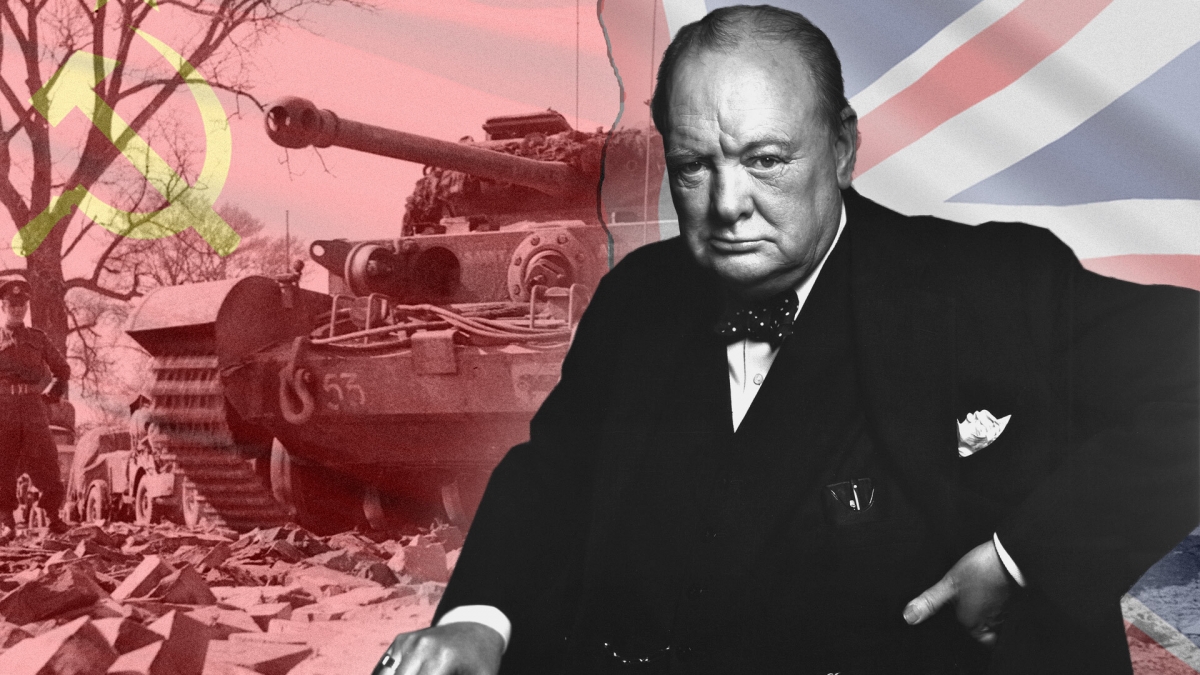The West planned to crush the Soviet Union right after World War II
In early May 1945, the Soviet Union and its Western allies finally completely defeated Nazi Germany with blows from both the East and the West. Europe was then devastated after years of war. Finally, the long-awaited peace has arrived. At that time, the idea that a new armed conflict might erupt was almost impossible. But there are still people who consider that possibility.

British Prime Minister Churchill once wanted to destroy the Soviet Union by military means right after World War II. Collage: RBTH.
Right before the activities to celebrate victory over Nazi Germany ended, British Prime Minister Winston Churchill instructed the British army to draw up a plan to attack the Soviet Union, scheduled to take place in the summer of 1945.
Eternal enemy
Prime Minister Churchill was an uncompromising opponent of Bolshevism. However, he became a staunch ally of Soviet leader Stalin in the common struggle against Nazi Germany. But when Red Army As the Soviet Union moved deeper and deeper into Europe and established pro-Soviet regimes in the newly liberated regions, Mr. Churchill’s mood changed.
Churchill wrote to Secretary of State Anthony Eden on May 4 of that year: “Terrible things have happened. A tide of Russian domination is rolling forward… After that tide has passed, the territories under Russian control will include the Baltic provinces, all of East Germany, all of Czechoslovakia, one most of Austria, all of Yugoslavia, Hungary, Romania, and Bulgaria”.
Prime Minister Churchill could think of nothing but the “terrible threat” the Soviet Union posed to the “free world”. Ten years later, in 1955, Churchill wrote in his memoirs about his thoughts in the midst of those days: “Japan was not yet conquered. The atomic bomb has not yet been born. The world is in chaos. The main link when facing danger together – the thread that once united the allies, is now gone. In my eyes, the danger from the Soviet Union has now replaced the Nazi enemy.”
On May 22, 1945, the British leader finally received his long-awaited plan, “Operation Unthinkable (“unthinkable”) from the Joint Chiefs of Staff of the Joint Chiefs of Staff. British War Department.
British version of the “Barbarossa” campaign
The purpose of this military campaign against the Soviet Union was clearly stated to “impose on Russia the will of the United States and the British Empire”. This ambiguous expression implies the expulsion of the Red Army and Soviet political forces from the territory of Germany and Poland.
Had this operation begun on July 1, 1945, 47 British and American divisions (including 14 armored divisions) would have launched two fierce attacks on Soviet forces in the North and South of the country. Virtue. After a successful operation, they will raid Poland.
In addition to the main force, this operation is expected to re-establish and rearm 10 divisions consisting of members of the former Nazi army, and at the same time bring in Polish anti-Soviet armed formations to harass them. behind the Red Army. It is emphasized that the Western allies have a strategic naval and air force advantage.
The British leadership was betting on a quick defeat of Soviet forces, forcing them to submit (at least temporarily) to the will of their Western allies and accept negotiations. If this scenario does not occur, armed conflict is allowed to escalate into all-out war.
Impossible Campaign
When proposing to Churchill a plan to attack the Soviet Union, the British generals failed to point out the complexity of the implementation. Total war is expected to be long and costly. From the experience of the Nazis, the occupation of vast territories of the Soviet Union did not bring about the collapse of the political regime there, nor did it end the resistance movement of an opponent with “huge human resources”. giant”.
Despite Allied naval superiority at sea, this force ultimately played almost no significant role in such a war.
The second strongest card – the total advantage of the strategic air force (2,750 Allied bombers versus 960 Red Army planes) was also difficult to deploy successfully: Distance to industrial facilities The Soviet Union was very large, but those facilities were scattered over the vast territory of the Soviet Union, making the deployment of attack aircraft on those facilities less effective than in the case of attacking Germany. .
However, the main factor that made “Operation Unthinkable” impossible was the huge number of Red Army. According to British calculations, to deal with 47 British and American divisions, Soviet Union could unleash a force as great as 170 Western divisions, including up to 30 armored divisions.
The British report read: “The current balance of power in Central Europe, where Russia possesses an approximate 3-to-1 advantage, makes it almost impossible for the Allies to win a complete and decisive victory in the region. that area in the present circumstances… Although the Allied organization was better, the equipment slightly better, the morale higher, the Russians proved to be formidable opponents of the Germans. They have competent commanders, adequate equipment, and a structure that, while perhaps less than our standards, has stood the test of reality.”
Military experts believe that the Soviet Union could take over Norway, Greece, and Turkey, thereby cutting off British and American fleets’ access to the Black Sea should a real conflict break out. Moreover, the prospect of Russia’s alliance with Japan is entirely possible.
From attack to defense
When the document of the attack plan was placed on the British Prime Minister’s desk, Chief of the General Staff Field Marshal Alan Brook publicly stated that the chances of success of this operation were very small and that now Russia had become a major power. really strong.
Finally, with a heavy heart, Prime Minister Winston Churchill abandoned the idea of attacking the Red Army and did not initiate any discussion on the subject with his American counterpart. Instead, he adopted a plan for the defense of the British Isles, still known as Unthinkable. This politician feared that if America withdrew most of its troops from Europe, Soviet leader Stalin would certainly not miss this opportunity to conquer the entire continent.
In fact, the Soviet Union, exhausted from the brutal war with Nazi Germany, would not launch any full-scale war on Europe. Against this background, on June 23, 1945, the law on army and navy conscripts was promulgated. Over the next few years, the Soviet armed forces were reduced from 11 million to 3 million.
In addition, the number of Soviet weapons and weapons stationed in Eastern Europe and Southern Europe also decreased significantly. Only a short time later, Soviet troops returned here, when the world had really entered the Cold War period.
at Blogtuan.info – Source: danviet.vn – Read the original article here

